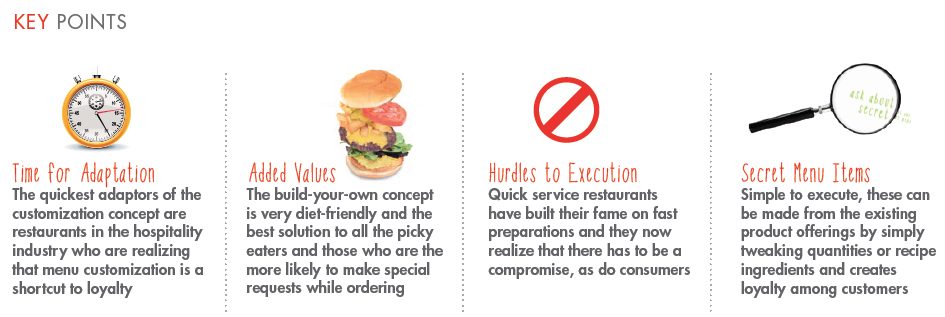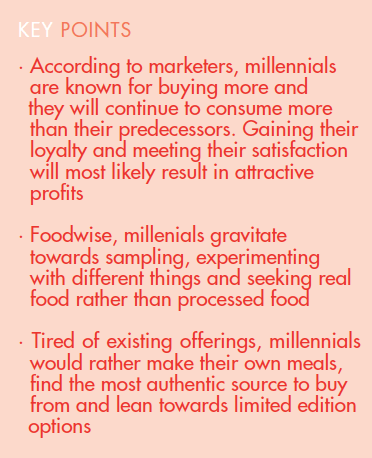
Menu Item Customization In Response To Millennial Expectations For Qsr & Fast Casual
“I would like the house special without tomatoes — can you put cucumber instead? Do you have plain bread instead of cereal? No mustard, please, I’ll have ranch on the side.” If you ever found yourself asking for exactly what you want instead of ordering what’s on the menu, you’re not alone. The majority of consumers are asking for special orders today and feel no shame about it. There are perfectly good reasons for these specific requests, from diet and allergy restrictions to taste preferences and calorie counts. Keeping pace with millennial satisfaction includes menu customization. This customization extends itself to QSRs and fast casual, where ready-to-go items used to be prepared in an assembly line cadence in the kitchen. Substitutions also used to be the pet peeve of foodservice establishments for years, but today they must be part of the daily routine for businesses. “Build-your-own” is becoming increasingly popular. How businesses respond to this growing demand without compromising quality and speed will be a defining factor of success.
The Millennial Generation Effect
Considered a birthright to the millennial generation, customized options for products and services have now become a necessity, especially in the foodservice industry. Create-your-own or build-to-order concepts are a huge hit because they offer Considered a birthright to the millennial generation, customized options for products and services have now become a necessity, especially in the foodservice industry. Create-your-own or build-to-order concepts are a huge hit because they offer opportunity for choices. Franchises don’t need to think twice on why they should satisfy these demanding consumers. According to marketers, millennials are known for buying more and they will continue to consume more than their predecessors. Gaining their loyalty and meeting their satisfaction will most likely result in attractive profits.
Hartman Group, a research consulting company, reported in the article “Marketing for Millennials” that millennials are masters of customization and self-expression. Characterized by “I know what I want” and “Cuz!” type of behaviors, millennials are more vocal about their needs and desires than their ancestors. They tend to see themselves as co-creators by shopping for original concepts and making it their own; they take power in their knowledge and access to immediate sharing of information. Foodwise, it translates into sampling, experimenting with different things and seeking real food rather than processed food. Tired of existing offerings, they would rather make their own meals, find the most authentic source to buy from and lean towards limited edition options. Fast casuals and quick service establishments are responding to this powerful and attractive market by offering build-your-own menu items. Chains such as Chipotle, Subway and Pizza Hut setups allow customers to choose their ingredients to include in their meal, and watch the whole production process.
Time for Adaptation
Once annoyed and sometimes offended by special requests, food businesses and chefs are beginning to realize that menu customization is a shortcut to loyalty. Changing ingredients used to be highly frowned upon in fine dining as chefs tended to protect their creations, but they are now seeing it as a challenge to make their dishes fit any and all diet restrictions. The quickest adaptors are restaurants in the hospitality industry. Where business travelers and vacationers are looking for an overall great experience, the food options have to be amenable to all diet restrictions and cater to everyone.

Added Values in Customers’ Perceptions
Chains that have a setting with employees behind the counter preparing the food in front of customers are finding success with millennials for many reasons, starting with transparency. Being able to see the ingredients and how they are incorporated enables customers to see the process, which enhances trust. Quality of the vegetables, meats, sauces and all ingredients on display can better be inspected from behind a transparent glass, and customers enjoy selecting the ones that look appetizing to them. Freshness goes along with transparency, and it is easier to judge by the look of the raw ingredients how fresh they are compared to a cooked meal on the plate. Interacting with the person preparing your meal is also a way of getting some answers for those who aren’t sure about the best ingredient combinations or who are concerned with diet restrictions.
The build-your-own concept is very diet-friendly, the best solution for picky eaters and those who are more likely to make special requests while ordering. Customers with allergies or food restrictions will also find it easier to create a custom meal. For those who are watching their waistlines, choosing from the vegetable offerings and not including sauces can be easily done as well. Choice is another great added value of the concept. Displaying a wide variety of ingredients symbolizes infinite options to choose from. There is nothing new about visual appeal. When clients get in front of large offerings, they can only feel inspired to create their meal. Many customers will even go for the “a little bit of everything“ recipe so they feel good about getting more for their buck, or simply in an attempt to satisfy a big hunger.
Hurdles to Execution
Providing customization equates to time and money. Quick service restaurants have built their fame on fast preparations and they now realize that there has to be a compromise, as do consumers. From a fast-paced kitchen where employees know how to assemble each item by heart to waiting on specialized orders, the flow time between order and checkout has and will continue to increase. Another thing to consider is the type and amount of ingredients as well as the diversity of menu items required. Menu selection can also be based on cultural or regional variances. Putting more on display achieves the added value patrons are looking for, which yields a higher investment. Where to stop when dealing with customization and how far restaurants should go to address all of their customers’ needs is a business decision that owners need to come to.
Secret Menu Items
Most consumers aren’t aware of the phenomenon, hence its appellation, but QSR magazine detected a growing trend in casual restaurants and QSRs which is to offer off-the-menu items that are being served to whoever will ask for them. The special order can be a burger stacking four patties and four slices of cheese from In-N-Out, a “Quesarito,” a cheese quesadilla wrapping a burrito at Chipotle, or a protein-heavy breakfast bowl at Panera. Partially a secret nowadays due to increasing popularity, the concept is largely disclosed on social media websites. Starbucks dedicates a website to its secret menu items, listing attractive flavors such as Ferrero Rocher or cookie dough Frappuccino. The brand also customizes for its fans with secret sizes such as “Trenta” (a 31 ounce pouring capacity glass) and secret teas like Peach Ring or London Fog. “Created for Starbucks Fans by Starbucks Fans” the coffee chain is proudly claiming its efforts to satisfy its customers’ whims. Being original and enjoying unique products is part of the millennials’ experience. They are getting more adventurous than their parents and seek to enjoy their own creations.
The innovative concept of secret menu items is making a big buzz for these quick service restaurants and succeeds in creating loyalty among customers. Simple to execute, it can apply to many items in a traditional setting made from the existing product offerings by simply tweaking quantities or recipe ingredients. Creating word-of-mouth and starting a buzz on the Internet is all that businesses need to make it work. Better than traditional in-store customization, the secret and limited aspects of these items bring all the excitement and have the power of making people feel special.
What used to be considered as extra customer service and going above and beyond, customization is now big business for QSRs and fast casual restaurants. Those who used to be perceived as being picky or rude to the server are in fact the precursors of a growing trend. With a few downsides such as time consumption and cost control to keep in mind, mass customization is nonetheless spreading in the industry. Customers see build-your-own items and special orders as added values that help build their loyalty with brands. Fresh, transparent and diet-friendly, the option of creating meals on the spot is giving the power the millennial generation seeks. We may hold a word of caution: once control is given, it will be hard to take it back. We are amidst the evolution of the foodservice industry. Customers who used to be influencers of menu items are becoming creators, and since they can ask for anything from A to Z, you better be ready!
